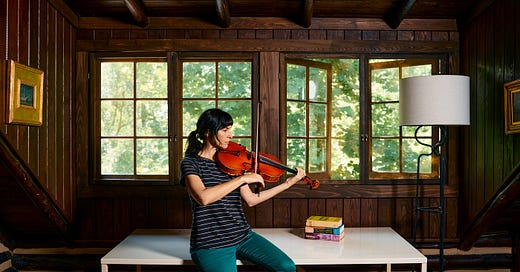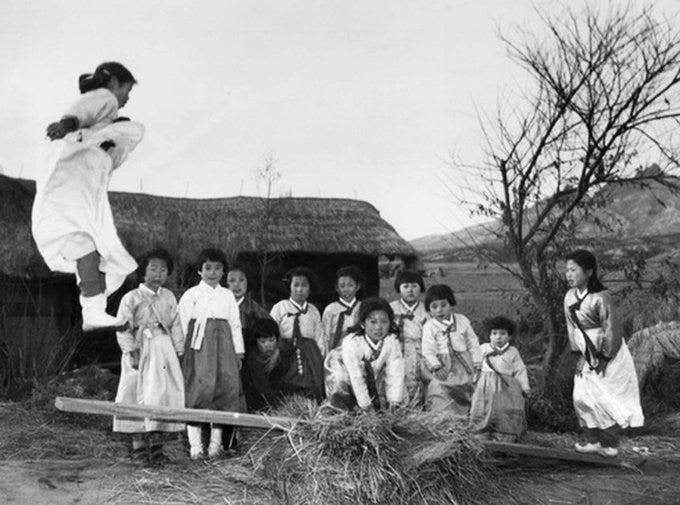On her new record, Clamor, Jessica Pavone explores freedom within constraint
"I have a real thing with control but I also want the musicians to have agency."
Violist/composer Jessica Pavone’s new record, Clamor, begins with a luxuriant, conversational push and pull of strings that slowly stretch and build, here and there clashing in mild disagreement. A pause, and a shift, and each instrument announces itself with a warm, resounding exclamation point. It’s as though every light in the house is being turned on, one by one, layering radiance at varying levels of wattage, before being gradually dimmed, and then again brightened. This first movement is characterized by such moments of lifting and lowering: At its center is a seesawing rhythm.
Pavone isn’t sure where the pattern came from, or why she was so drawn to it, but as she began composing the piece, she says, “I just started thinking about seesaws; researching seesaws.”
That movement, “Neolttwigi,” is named for a standing seesaw invented in the 17th century by married Korean women who, forced to stay within the bounds of their property, used the device to peek over the walls. While continuing to write the piece, Pavone researched other liberatory inventions by women. She titled the piece’s second and third movements — which feature improvised solos by bassoonist Kathrine Young — “Nu Shu, Pt. 1” and “Nu Shu, Pt. 2” after a secret language created by Chinese women who weren’t allowed to go to school. The fourth movement, “Bloom,” is named after women's rights activist and dress reform pioneer Amelia Bloomer.
For her previous record, Lull, Pavone composed a suite for eight string players — viola, violin, cello and double bass, each times two. The piece featured improvised solos by percussionist Brian Chase and trumpet player Nate Wooley. “It was one of the largest pieces I’d completed in a while and I was like, ‘Oh, I like working on this big scale, I want to do another one like this,’” she explains over Pellagrinos outside a small coffee shop in our shared neighborhood of Astoria, Queens.
She’d arrived at the title Clamor first, the opposite of Lull, but planned to do something structurally similar: four movements with eight string players and two soloists. “I was trying to think of improvisers that I would want to work with,” she said. “What’s important to me is that I have a personal relationship with the person and know their language really well.”
Young — an artist noted for expanding the vocabulary of the bassoon, and one of Pavone’s long-time friends and collaborators — came to mind. “I couldn’t think of another person so I just thought, “I’m going to write two movements for Katie!”
With the bassoon helping to fill things out on the low end, Pavone got rid of one cello and one bass. In addition to Pavone on viola, the string ensemble includes violinists Aimée Niemann and Charlotte Munn-Wood, violist Abby Swidler, double bassist Shayna Dulberger, and cellist Mariel Roberts. That the lineup is composed entirely of women and non-binary artists was, contrary to some assumption from critics, merely a nice coincidence.
With Young’s own esoteric language at the center, the wildly dynamic sibling tracks “Nu Shu Pt. 1” and “Nu Shu Pt. 2” move into atonal abstraction, opening with an extended, hovering, horn-like call, then petering into a papery flutter, before again changing course. A stretch of pops and clicks and sighs build to full-on free-jazz cacophony, which is broken by the fittingly pastoral opening of “Bloom.”
Young’s tone is sometimes harsh and mechanical; other times it feels verdant and elemental, like wind through tall grass, or heavy beating of wings. Young creates sound that is not entirely unfamiliar but can’t quite be pinned down. Pavone, in her solo work, often tries to make her viola sound like something else, and Young, she says, does something similar with the bassoon. “It’s almost like the instrument becomes your noise machine.” Young’s experience as a composer, and deep familiarity with Pavone’s musical language, presented another dimension of productive push-and-pull. “My tendency is to rush through things because I don't want to bore people,” Pavone says. “And Katie is like, ‘Jess, I think we could stay in this sound space a little bit longer.’”
Pavone, who has released some 28 records as a lead or co-lead, and appeared on at least 30 more, studied classical performance at a conservative music conservatory. She hated it so much that she figured, when she was done, she’d abandon music altogether. Then she discovered free improvisation.
After a wide-eyed honeymoon period with improvisation — “I just had this false idea of, ‘It's always good, it always works” — she began to realize that sometimes, in fact, it doesn’t work, and sometimes it sounds bad. “And that’s kind of how I started writing music. I was like, ‘OK, free improvisation is really cool, it’s opened my mind.’
“But maybe that control freak side of me was like, ‘OK, it’s a 50/50 chance that it will be good. What if i make sure it’s actually going to be good?’”
As a composer she often uses time-based scoring, which provides space for musicians to move independently within a structure. She’ll ditch bar lines — which evenly measure out time in metered notation — and place material inside a “cell.” There might be four cells in a row. At the beginning of the first cell there will be a time window of a few seconds, which is the timeframe to enter the cell, and musicians move into the cells at slightly different times. It’s not a free-for-all, but it gives the players a little extra room. “It’s the idea that a lot of the materials are meant for the players to play independently of one another so then you might get some really complicated polyrhythmic things happening or weird dissonances.
“I’ll deliberately put in pitches in the different voices that would clash at different times,” she adds. “If you tried to notate what was happening you’d have to write these really complex rhythms and there’d be a lot of counting. But if you just say ‘alternate between these four pitches at your own chosen rate, independent of everyone around you’ you sort of get this ping-pong of chords that I couldn’t write.”
Pavone’s compositions are both sophisticated and extremely textural, in part because she cares almost as much about how they feel as how they sound. “If I want to [move] from one pitch to another and it's kind of an awkward jump I’m like, we’re not doing it, we’ll find another way,” she says. “I want it to feel good to play.”
It’s not that she’s trying to write “easy music,” she says, “but if it’s easy to play on the instrument you can dig in and get something deeper out of it, you can be more of yourself, more of your body, more of your mental state can be focused. …I don’t want dexterity to be a distraction. I also want [everyone] to feel like they’re in the piece playing it together.
“If you have less material to work with, you’re listening to each other more, and reacting to each other more. So I have a real thing with control but I also want the musicians to have agency.”
Ultimately, she says, she’s less interested in control than in keeping herself accountable to the group. “I’m going to give you enough material to guarantee that this isn’t going to flop,” she says. “I want to give you enough information that we’re going to be able to create something together.”
Press surrounding this release, such that it is in today’s beleaguered arts journalism climate, has described Clamor as a “contemplation on female empowerment” and an interpretation of “women’s work through the ages,” and so on. It’s not that these descriptions misinterpret Clamor, exactly. But presented with an identitarian hook, writers have a tendency to miss the point, projecting a didactic storyline on something not so easily definable. How can something this abstract and organic, Pavone asks, really be “about” anything?
While she almost never works within such a clear narrative framework — and can only remember having done it once before — Pavone liked having the thread to draw it all together. “I felt like I learned something by sharing this information. And I liked the idea of, ‘I can’t do this, I’m going to figure out another way.’ That’s where innovation comes from.”




